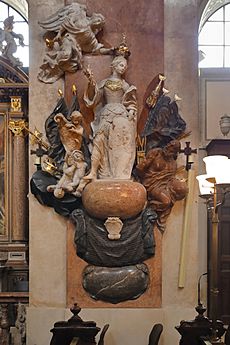Ernst Rüdiger von Starhemberg facts for kids
Quick facts for kids
Ernst Rüdiger von Starhemberg
|
|
|---|---|

Portrait, copy after Peter Schenk the Elder
|
|
| Born | 12 January 1638 Graz, Duchy of Styria |
| Died | 4 January 1701 (aged 62) Vösendorf, Archduchy of Austria |
| Buried | |
| Allegiance | |
| Service/ |
Imperial Army |
| Years of service | c.1660–1701 |
| Rank | Generalfeldmarschall |
| Battles/wars | Great Turkish War
|
| Awards | Order of the Golden Fleece |
Count Ernst Rüdiger von Starhemberg (born January 12, 1638 – died January 4, 1701) was an important military leader in Austria. He was the military governor of Vienna starting in 1680. He is most famous for defending the city during the Battle of Vienna in 1683. He also served as a general for the Holy Roman Empire during the Great Turkish War. He was a member of the noble House of Starhemberg.
Contents
Ernst Rüdiger von Starhemberg's Life
Ernst Rüdiger von Starhemberg was born in Graz, a city in Styria, on January 12, 1638. His father was Count Conrad Balthasar von Starhemberg. His cousin, Count Guido von Starhemberg, also became a famous soldier. Guido fought alongside Ernst as an assistant. In the 1660s, Ernst Rüdiger von Starhemberg fought against French and Ottoman armies. He served under the Imperial Lieutenant General Raimondo Montecuccoli.
Defending Vienna in 1683
In 1683, Ernst Rüdiger von Starhemberg was the military commander of Vienna. He had fewer than 20,000 soldiers to defend the city. About 120,000 Ottoman soldiers were attacking. On July 15, 1683, the Ottoman commander, Kara Mustafa Pasha, offered Vienna a chance to surrender. Starhemberg refused this offer. He was counting on help from the Imperial army. This army was sent by the Habsburg emperor Leopold I. The emperor had left his home in Vienna for safety. Starhemberg also trusted the strong city walls. These walls had been made stronger after the first Ottoman attack on Vienna in 1529.
After two months, Vienna was almost defeated. The relief army arrived in early September. This army was led by the Polish king Jan Sobieski. The Ottoman soldiers had dug tunnels under the walls. They filled these tunnels with gunpowder and blew them up. This created holes in Vienna's defenses. Finally, on September 12, 80,000 Polish, Venetian, Bavarian, and Saxon troops attacked the Ottomans. They defeated them in the Battle on the Kahlenberg.
After the Siege
The emperor recognized Starhemberg's actions in saving Vienna. He promoted Starhemberg to the rank of a field marshal. He also made him a state minister. Starhemberg then pursued the retreating Ottoman troops. In 1686, during the Siege of Buda, he was badly hurt. He was shot in his left hand and had to give up his command. In 1691, he became President of the Hofkriegsrat. This council was in charge of organizing the Habsburg army.
Personal Life
Ernst Rüdiger von Starhemberg married twice. His first wife was Countess Helena Dorothea von Starhemberg. After she died, he married Countess Maria Josepha Jörger von Tollet in 1689. He had children from both marriages. A later Austrian politician, Ernst Rüdiger, Fürst zu Starhemberg (1899-1956), was one of his descendants.
Death
Starhemberg died in Vösendorf on January 4, 1701. He was 62 years old. His tomb is in the Schottenkirche in Vienna. It was designed by Joseph Emanuel Fischer von Erlach.
Legacy
Later generations have seen Starhemberg as a hero. They consider him a savior of the Western world and its culture. In 1872, Emperor Franz Joseph I of Austria ordered a statue to be built in his honor. This statue is at the Heeresgeschichtliches Museum in Vienna. The museum has many exhibits about the Battle of Vienna. Starhemberg's sword and armor are also on display there.
See also
 In Spanish: Ernst Rüdiger von Starhemberg para niños
In Spanish: Ernst Rüdiger von Starhemberg para niños
- Starhemberg



